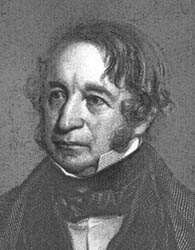Nathan Appleton
Nathan Appleton (born October 6, 1779 in New Ipswich , Hillsborough County , New Hampshire , † July 14, 1861 in Boston , Massachusetts ) was an American politician . Between 1831 and 1833 and again in 1842 he represented the state of Massachusetts in the US House of Representatives .
Career
Nathan Appleton was a cousin of Congressman William Appleton (1786–1862) and the father-in-law of the writer Henry Wadsworth Longfellow (1807–1882). He attended public schools in his home country and studied at Dartmouth College in Hanover . He later worked with his brother in his import shop in Boston. Appleton is one of the founders of the cotton mill in Waltham . In 1821 he was also involved in founding the town of Lowell . At the same time he embarked on a political career. Between 1815 and 1827 he was a member of the Massachusetts House of Representatives on several occasions . In the 1820s he joined the movement against later President Andrew Jackson and became a member of the National Republican Party . He later joined the Whig Party, founded in 1835 .
In the 1830 congressional election , Appleton was elected to the US House of Representatives in Washington, DC in the first constituency of Massachusetts , where he succeeded Benjamin Gorham on March 4, 1831 . Since he renounced another candidacy in 1832, he could only complete one legislative period in Congress until March 3, 1833 . Since President Jackson took office in 1829, there has been heated debate inside and outside of Congress about its policies. It was about the controversial enforcement of the Indian Removal Act , the conflict with the state of South Carolina , which culminated in the nullification crisis , and the banking policy of the president.
After the resignation of MP Robert Charles Winthrop , Appleton was elected as the Whigs candidate for the by-election for the first seat of his state as his successor in Congress, where he took up his new mandate on June 9, 1842. However, he only did so for a few months until his resignation on September 28 of the same year. Also in 1842 Appleton was elected to the American Academy of Arts and Sciences . After his tenure in the US House of Representatives finally ended, Nathan Appleton worked in commerce. He died on July 14, 1861 in Boston, where his 1821-built house as a National Historic Landmark in the National Register of Historic Places is registered.
Web links
- Nathan Appleton in the Biographical Directory of the United States Congress (English)
- Nathan Appleton in the database of Find a Grave (English)
| personal data | |
|---|---|
| SURNAME | Appleton, Nathan |
| BRIEF DESCRIPTION | American politician |
| DATE OF BIRTH | October 6, 1779 |
| PLACE OF BIRTH | New Ipswich , New Hampshire |
| DATE OF DEATH | July 14, 1861 |
| Place of death | Boston , Massachusetts |

